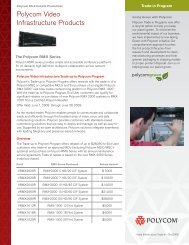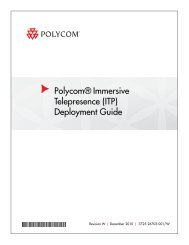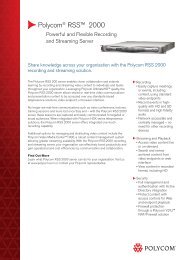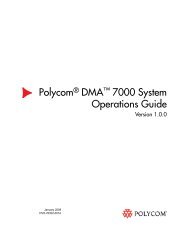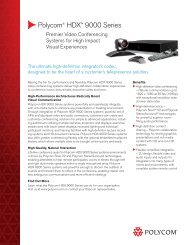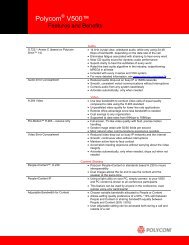Picturetel Livelan Version 3.01 Release Notes
Picturetel Livelan Version 3.01 Release Notes
Picturetel Livelan Version 3.01 Release Notes
Create successful ePaper yourself
Turn your PDF publications into a flip-book with our unique Google optimized e-Paper software.
million, or "24 bits/pixel" all refer to a very high quality mode that does NOT produce better results, but does cause an<br />
extra step in the video display to take place and will reduce performance for no improvement in quality.<br />
6.2 Sluggish video<br />
Verify that the display is set to either 32768 or 65536 (high-color) and not 256 or 16 million color mode. The render<br />
times will be much longer due to the conversion needed to render in 256 or 16 million color formats.<br />
6.3 Video driver problems<br />
LiveLAN places a heavy demand on video display hardware. The video display in the LiveLAN application is fairly<br />
typical of the kind of video display used by many multimedia applications with the exception that it may be running at<br />
30 frames per second with rapid screen updates. These requirements are actually quite basic but can aggravate<br />
some display cards.<br />
If you have video related trouble please verify that you have the latest drivers from your card's manufacturer.<br />
6.4 Blocky or poor quality video and audio<br />
Blocky or poor quality video and audio are usually caused by network or system performance issues. Some of the<br />
causes can include:<br />
• Poor NIC card throughput from:<br />
• a low performance non-DMA NIC card,<br />
general overload of your host CPU, or<br />
too much network traffic through your system.<br />
• Network Congestion from:<br />
• too much traffic on the network, or<br />
an overloaded network hub, switch, or router.<br />
You may be able to mitigate the problem by choosing a lower bandwidth for your calls. For example, 384Kbps calls<br />
on a busy 10Mbps non-switched Ethernet networks or poorly performing machines tend to have more video and<br />
audio performance problems. Reduce your bandwidth settings to 174Kbps and see if quality improves.<br />
If lower bandwidth calls show blockyness, consult your network administrator who may be able to characterize your<br />
network performance or improve your network access.<br />
Network hits (lost or late packets) WILL cause video blockyness. If your overall network performance is good, these<br />
problems will clear up in 15-30 seconds. If you are running other network intensive operations on your PC while in a<br />
videoconference, blockyness will NOT clean up until that operation is complete. This may include file transfers using<br />
LiveShare Plus.<br />
Blockyness CAN occur even in video loopback calls. If your system is slow or has other network traffic, packets will<br />
b l t i id l b k ll Thi i h t i ti f th ll l ti IP t k t l d f id i





